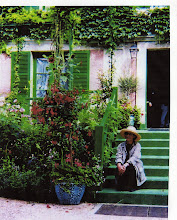I have chosen Nantucket as my home because I fell in love with the unusual plant community that is indigenous to the Island.
I work closely with my clients in designing a garden/landscape that they would love to live in, but perhaps cannot visualize themselves. I also work within the principals established at my nursery: Do No Harm - So the garden can remain a source of joy within our fragile ecosystem.
My initial visit to a new site is $500. From this I can give a quick overview of your site, problems I can spot, plant communities we need to be aware of - information from the surface of the site. Should you wish to proceed following the initial visit the process involves the following steps:
1. Initial meting to gather all the elements you would like in your garden. I ask that you collect images - from magazines, books, photos for your travels - "a picture is worth a thousand words.." We list all the uses the garden will have. From this I can draw up the brief, which forms the basis for the design.
2. Survey the site. Sun angles, drainage, soil analysis, sound, views from the interior, areas needing screening, wind direction, native plant communities. Depending on the complexity of the site I may sometimes enlist a professional Surveyor, whose fee would be billed separately from design fees.
3. Using the above I can then develop an outline design, which does not include all the detailing, but will give an idea of the proposal. We meet again to discuss this and make any changes clients may feel are necessary. If changes are significant we have other meetings to discuss, until we arrive at a comfortable design outline. I will not move on until everyone is happy with the design.
4. The agreed design is then sketched out with detailing, ready for the estimating. I much prefer to do the installation of the design working with my own crew, or specific contractors with who i have experience. I will give you an estimate quote based on the survey, design, planting plan.
Often times designs need to be broken into areas of priority, land use problems, budget, are all considerations in executing the design. It is very helpful if you have a budget in mind, as well as your priority areas.
5. I then begin the process of procuring planting material, scheduling components of the design installation.
Fees are calculated on the basis of the size, complexity and location of the site. My fee of $85./hr applies to hours in meetings, drawing plans, developing estimates for the design. i charge a 15% administrative fee applied to the installation to cover time spent ordering and collecting plants and materials, and additional up date meetings once we have begun the installation process. On site supervision time is charged by the hour.
I usually request a 50% deposit on the client accepting the design and committing to the installation. Further payments that might be required during the execution of the design installation. If the design process is delayed for a significant time, for example by planning applications, a staged payment may be requested after discussion with my client. If for any reason the design process is terminated before completion, an invoice will be submitted for work completed up to that point.
Additional charges:
Changes made during state 4 and 5 will require evaluation and new estimates
Installation:
1. A 50% deposit against plant and material procurement is required
2. Plants ordered, trees viewed and selected, stone viewed and selected, subcontractors scheduled, materials arrive.
3. Schedule determined
4. Soils work performed
5. Installation of hardscaping, plants, irrigation, mulch
6. Installation complete, final payments due.
7. Follow up work to assure success of the installation - 3 years, working with yet to be determined landscape maintenance personnel. If you have a dedicated landscape crew, I will work with them on an hourly basis to train them to the specifics of the garden. I will assume that my crew will be assigned unless notified otherwise.










 There have been so many requests over the last 15 years to rent space in The Gardens for special events - Weddings, Benefits, Birthday parties, engagement parties - now that the nursery and shop are closed, we have the time to accommodate those requests.
There have been so many requests over the last 15 years to rent space in The Gardens for special events - Weddings, Benefits, Birthday parties, engagement parties - now that the nursery and shop are closed, we have the time to accommodate those requests.
